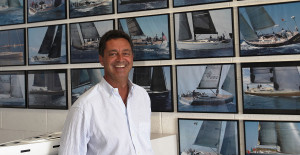“By doing its work conscientiously, Vismara has always followed this simple axiom: there is no design without innovation, and innovation is a risk if there are no solid technical foundations. This is why the company is so committed to research and technology: the foundations of design development and, even more importantly, the source of our enthusiasm.”
Scientific research in the dual setting of hydrodynamics and aerodynamics has allowed Vismara to develop hull shapes, sail plans and keels. This is because research brings us to awareness of the factors governing performance. VPP programs, tests in tanks, and systematic hulls have supported the development of the company since its inception, supplying the necessary support to design decisions. Today, to continue with development, we need increasingly advanced programs, derived from industrial or aeronautical sectors. This is the reasoning behind our decision, in 1998, to create the ICAD (International Consortium for Advanced Design) of which the University of Florence and its Energy Faculty is a fundamental part. The purpose of this consortium is to promote the exchange of information and experience between industries, research centres and academic institutions. At the base of it all, powerful Computational Fluid dynamics (CFD)software to analyse hulls, keels, wing profiles and sail plans in experimental configurations. This means tank tests or wind tunnel testing can be simulated on a computer.
Keels, profiles, optimised sails and through to cutting-edge wing masts: in Vismara the work of the research division together with the consortium is of fundamental importance. Starting with the assumption that a sail yacht is a unit comprised of forms and structures, research has allowed Vismara to look better at the relationship between shapes, structures and construction materials. And so, over the years, Vismara has always carried out pioneering activities: from the bonded monolithic structure to vacuum prepregs, baked in the oven, to the latest vacuum infusion systems. Structural analysis uses finite element modelling from the aerospace and aeronautical industries to optimise laminates and to increasingly integrate structures with fittings and installations. However, it doesn’t end here: research is constant, for example in the design area too. In ergonomics, space division, movement elements and on to the use of new finishing materials. It is a whole comprised of factors, which has led Vismara to create craft that combine great usability with advanced structural and hydrodynamic optimisation concepts.
In short, another boost for the concept of fast cruising yachts with the same basic design as a regatta craft. For many years, Vismara has been working to pass on to the cruiser the conviction, or better still, claim, that their vessel can hold the sea, while moving like a modern racer. This is true to the point that, with the restrictive regatta rules, modern high-tech fast cruisers have now exceeded the performance of regatta vessels. If we add a better construction and more careful finishes, then it is possible to understand the leap forward made by the entire industry.

